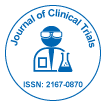
Journal of Clinical Trials
Open Access
ISSN: 2167-0870

ISSN: 2167-0870
Case Report - (2015) Volume 5, Issue 5
Adult dermatomyositis is a rare inflammatory myopathy associated with typical cutaneous lesions and an increased incidence of internal malignancy, notably female genital tract and breast cancers. It presents as a paraneoplastic syndrome in up to 25% of cases. In this report, we present a case of a 68 year old woman presenting a paraneoplastic dermatomyositis revealed by necrotic skin ulcerations. Predictive factors can improve prognosis of dermatomyositis due to earlier diagnosis of associated cancer. In our observation as in litterature review, cutaneous necrosis lesions are highly predictive of an associated neoplasia.
Keywords: Necrotic skin ulcerations; Paraneoplastic dermatomyositis; Breast neoplasma; Predictive factor
Dermatomyositis is a form of idiopathic inflammatory myopathy that involves skeletal muscle and skin. Its prognosis is related, firstly, to interstitial lung disease, and also to its association with cancer [1]. We describe a case of paraneoplastic dermatomyositis associated with breast neoplasma previously unknown.
A 68 year old Moroccan woman presented with a 3 month history of necrotic skin ulcerations affecting her arms and upper trunk. The evolution was marked by the installation of a pruritic rash and profound muscle weakness of the upper arms and shoulders that progressed rapidly to involve the lower extremities, totally disabling her. Physical examination found five ulcers on upper extremities, chest (Figure 1) and abdomen whose size varies between 2 mm and 5 cm, cutaneous lesions that were erythematous, slightly scaly, macular, and papular, involving the neck (Figure 2), upper chest, arms, and hands. There was violaceous facial erythema with a heliotrope eyelid rash.
Laboratory tests showed inflammation (leukocytosis 17300/mm3, inflammatory anemia 9 g/dl), aspartate aminotransferase (AST) and lactate dehydrogenase (LDH) were twice the normal, creatine kinase (CPK) and cratinuria were normal. Electromyograma revealed increased insertional activity and spontaneous fibrillations. Muscle biopsy showed a keratinocyte necrosis. In front of the acute onset of symptoms, the presence of necrotic ulcers and itching, neoplastic origin was suspected. Mammography coupled to ultrasound detected a lesion measuring 15 mm × 17 mm classified -according to the ACR BIRADS 5® Atlas (ACR: American College of Radiology), at the the right breast. Histolopathological examination was in favor of infiltrating ductal carcinoma. Abdominopelvic scan and scintigraphy does not objectify metastasis. The diagnosis of paraneoplastic dermatomyositis secondary to breast carcinoma stage I was confirmed. The patient was started on prednisone 80 mg/day. She was dead three days later by pulmonary embolism.
The diagnosis of dermatomyositis and breast cancer is done simultaneously. The association between dermatomyositis and visceral malignancy was described for the first time in 1916 by Stertz [2]. Published studies report a wide variation in the estimated risk of malignancy in patients with dermatomyositis, ranging from 6 to 60% [3]. The risk increases with age, black race, acute onset, male gender, pruritus, refractoriness to systemic steroid therapy, a sedimentation>40 mm in the first hour. In our case, the impairment of the general condition may be part of dermatomyositis as well as cancer. While the presence of necrotic ulcers represents a specific clinical element for neoplastic origin [4-6].
Gynecological cancers represent 33% of all cancers including breast cancers (17%), ovarian cancers (9%) and uterine cancers (7%) [3]. Therefore, routine screening should be made in women over 40 years by gynecological examination, mammography, ultrasound or pelvic tomography and vaginal smear [7].
Infiltrating ductal carcinoma represents 75% of all breast cancers [5,6]. The tumor corresponds to a stellar lesion, badly limited. histology shows Atypical tumor cells form ribbons, tubules or nests, broke the basement membrane of the duct and infiltrate the surrounding tissues. the 5 year survival rates are about 80%. The treatment combines surgery, radiotherapy and medical treatment. Indications are posed by stage and development of the tumor, patient's general condition and the availability of treatment.
The diagnosis of dermatomyositis requires an etiological investigation in search of a paraneoplastic origin. The presence of skin necrosis lesions constitutes a specific predictive factor.